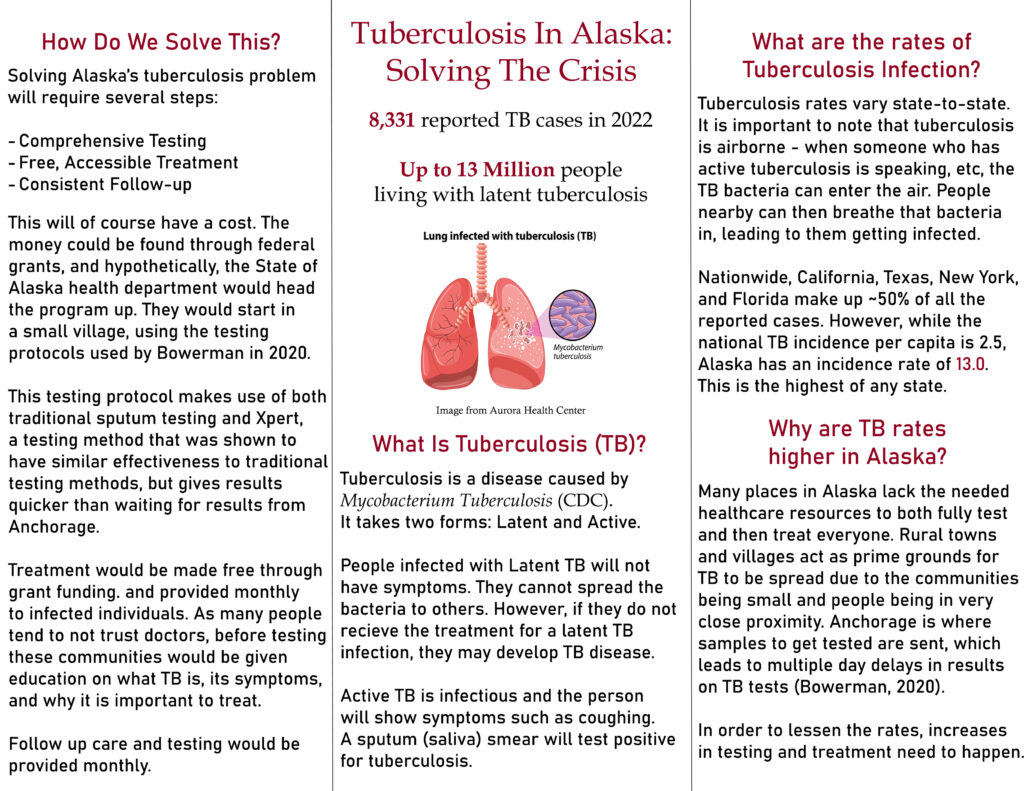Tuberculosis is widespread. Alaska is the 8th least populated state (only Vermont and Wyoming have less people), yet we have a tuberculosis incidence rate of 13.0 per capita. So how did it get this bad in the first place, and what do we even do about a disease that can lie dormant for years?
For my art piece, I chose to make a pamphlet in Photoshop (I like using photoshop, and I’ve always liked pamphlets as a way to spread information.) My idea on solving tuberculosis is partially detailed on my pamphlet – And the other part of it would be the type of information given out to help people understand why A. this cause should be supported, and B. what could be given to affected individuals to help them understand and hopefully trust the people working with them to treat TB enough to be involved in their treatment. Design-wise, I chose the color red to make the titles pop because it’s the color of World TB Day (March 24th). I aimed my pamphlet towards the people that, like I did before this class, have heard of TB before but don’t really know what it is.
My idea for solving TB came from one of my research papers. The group of researchers had gone out to Bethel, AK, to compare a new, quicker acting test to much slower conventional samples. A big reason TB has gotten to be as much of a problem as it is in our state is because apparently, the ONLY LAB capable of testing for TB is in Anchorage. That, compared with latent TB becoming active TB, and the fact that practically everyone ends up with the symptoms associated with TB (coughs, fevers, etc – very common things in Alaska in the wintertime). If we can get the people most at risk helped (that being Alaska Natives, who also have high rates of other risk factors for TB such as diabetes, renal failure, and homelessness) that can help us lower our TB infection numbers, and help protect others in these communities who have not yet contracted the virus. To catch all of it, we would need to test everyone with sputum samples to catch both latent and active TB. Then, the treatment needs to be free and available. The patients will need to be followed up with on a regular basis, both to make sure the meds are working and to cover any bases. In my mind, the easiest way to do this would be monthly visits from the same doctors that the patients hopefully trust.
I took a special interest in TB because it has such a strong grip on a group that is underprivileged and underserved, and also because of my late grandmother. My Grandma Matz, like her husband (pastor), was an ELCA (church group) minister (I believe, she was able to give sermons and such but not be the main pastor of a church). As such, she would fly out to Kaktovik (North, near Utqiagvik but closer to the Canadian border) and perform baptisms, services, etc. That community greeted her, a white woman in her 60s at the time, with a surprising amount of sarcasm and sass, as if she was one of their own. In a way, if doing this project can do anything, I hope it can raise awareness about an issue that could harm many of those people that also loved my grandmother. She passed about this time last year, so I kind of did this as a tribute to her as well, because I’m sure she’d be proud of it.


ABSTRACT(by Elijah Mead):
Many people revere Alaska for its peaceful solitude facilitated in part by its low population density. It is this same low population density that makes it so surprising that the state of Alaska has high rates of tuberculosis (TB), with a rate of 13.0 cases per capita. The STEAM project “Tuberculosis in Alaska: Solving the Crisis,” a pamphlet by Rebekah Matz discusses: What tuberculosis is, why TB rates are higher in Alaska, and the possible solutions to this rising issue. Tuberculosis is a respiratory disease caused by Mycobacterium tuberculosis. It appears in two forms Latent TB(dormant and non-infectious), and Active TB(symptomatic and infectious) with Latent TB being able to, in some cases, grow to become Active TB in the future. The pamphlet states that a reason for the higher rates of TB in Alaska is the inefficient testing process, with samples having to be shipped to Anchorage for screening. This makes it hard to prevent TB since more people can be unknowingly exposed during the turnaround time. Furthermore, Alaska’s rural communities are especially at risk for TB due to the smaller size and proximity to others in the community. Lastly, the pamphlet discusses 3 ways to possibly solve the aforementioned TB issues: comprehensive testing, free and accessible treatment, and consistent follow-up.